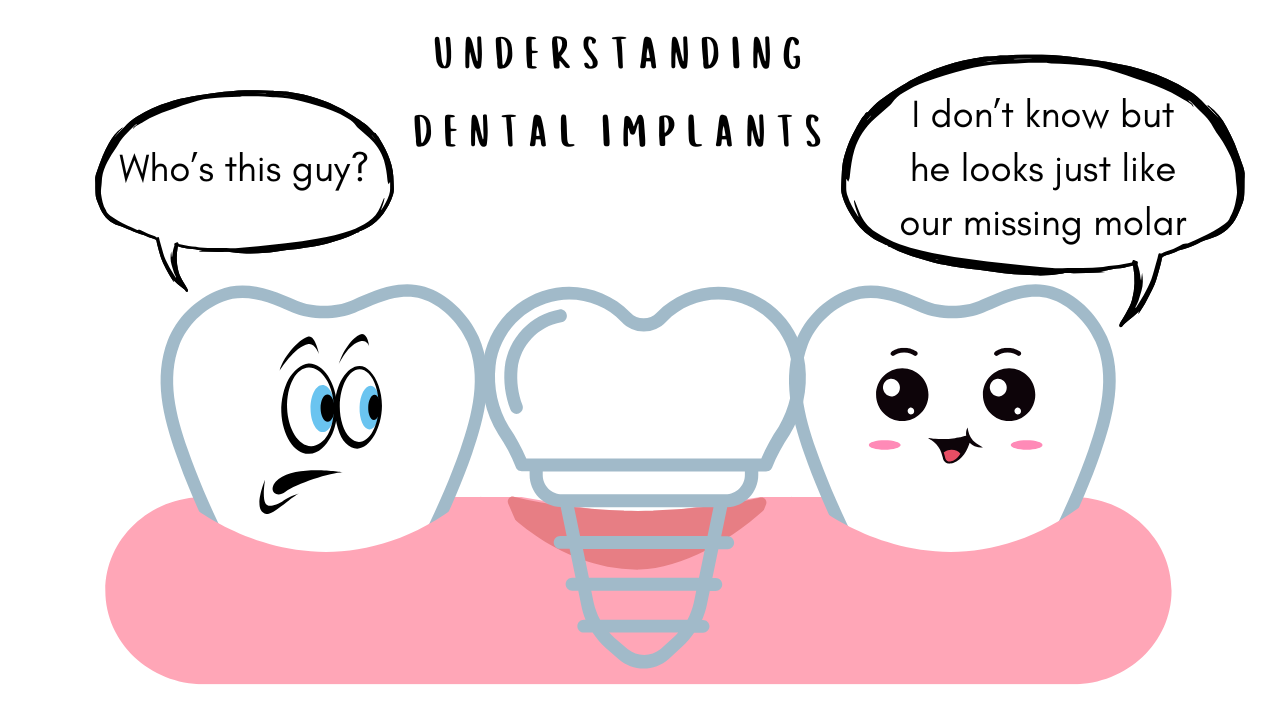A Guide To Dental Implants: What You Need To Know


Did your dentist just suggest a dental implant for that space where you’re missing a tooth? Don’t worry we’ve got you covered with this blog explaining what dental implants are and how they work.
What is a dental implant?
A dental implant is a small, titanium post or frame that a dentist surgically places into the jawbone beneath your gums. This post serves as a replacement for the root of a missing tooth, providing a sturdy foundation for a crown, bridge, or denture.
Dental implants are often considered the gold standard for replacing a missing tooth.
What are the steps involved in placing a dental implant?
Placing a dental implant involves several key steps to ensure a successful and long-lasting result. Here's an overview of the process:
1. Initial Consultation and Assessment
Medical History Review: The dentist will review your medical history to ensure you are a good candidate for an implant.
X-rays/CT Scans: Imaging will be taken to assess the health of your jawbone and determine the precise location and size for the implant.
Treatment Plan: A personalized treatment plan will be developed, including details of the implant procedure, anesthesia options and timeline.
2. Tooth Extraction (if needed)
If the tooth being replaced is still present, it will be extracted before the implant placement.
Bone grafting may be necessary if the extraction site doesn't have enough healthy bone for the implant.
3. Placement of the Implant
Anesthesia: Local anesthesia is used to numb the area, or sedation may be used for more complex cases.
Surgical Procedure: The dentist makes a small incision in the gum to access the jawbone. A hole is then drilled into the bone, and the implant (a small titanium post) is placed.
Healing Cap: In some cases, a healing cap is placed over the implant to promote healing and prevent tissue growth over the implant site.
4. Osseointegration
Over the next 3 to 6 months, the implant will fuse with the bone in a process called osseointegration.
5. Abutment Placement
After osseointegration, a small procedure is performed to attach the abutment (a connecting piece) to the implant. This is usually done under local anesthesia.
The gum is then stitched back around the abutment, and you may need to wait a few weeks for the gum tissue to heal.
6. Impressions and Custom Crown
Once the implant and abutment are securely in place, the dentist will take impressions of your mouth to create a custom crown.
These impressions ensure that the crown fits perfectly with your bite and surrounding teeth.
7. Placement of the Final Crown
After your custom crown is made, it is carefully attached to the abutment, completing the implant process.
The dentist will make any necessary adjustments to ensure the crown fits comfortably and functions like a natural tooth.
8. Follow-Up Care
After the implant is in place, regular check-ups are essential to ensure it is healing well and that the implant remains secure.
Good oral hygiene and periodic professional cleanings will help ensure the long-term success of the implant.
How long does it take for the implant to get fused to the bone?
Research typically shows that the process can take anywhere from 3 to 6 months, but it can vary depending on several factors:
Bone Quality: If the patient has good bone density and health, osseointegration may occur faster. In cases where bone grafting is needed, the process might take longer.
Implant Location: Implants in the lower jaw (mandible) tend to integrate more quickly than those in the upper jaw (maxilla), as the bone in the lower jaw is denser.
Patient Health: Good overall health, along with proper oral hygiene, can speed up the process.
Type of Implant: Some modern implants are designed to promote faster integration.
On average, it is recommended to wait around 3 to 6 months before placing the final crown or restoration to ensure that the implant has fully integrated with the bone. However, some advanced techniques and technologies may shorten this timeframe.
Your dentist will monitor the healing progress to determine the right time for the next step in the implant process.
What are the types of dental implants available?
There are several types of dental implants available, and the choice of implant depends on the patient's specific needs. Here are the main types of dental implants:
1. Endosteal Implants
Most Common Type: These are the most widely used type of dental implants.
Placement: They are placed directly into the jawbone.
Structure: They typically consist of a titanium post that serves as a root replacement for the missing tooth. After the implant fuses with the bone (osseointegration), a crown, bridge, or denture is attached.
Best for: Most patients with sufficient jawbone density and health.
2. Subperiosteal Implants
Less Common: These implants are placed under the gum but above the jawbone.
Placement: Instead of being placed into the bone, the implant frame is positioned beneath the gum tissue and rests on top of the jawbone. The posts then protrude through the gum to support the dental restoration.
Best for: Patients who have insufficient bone height for traditional implants and who do not want bone grafting surgery.
3. Zygomatic Implants
For Severe Bone Loss: These are used when there is severe bone loss in the upper jaw (maxilla), making traditional implants impossible.
Placement: Instead of being placed in the jawbone, these implants are anchored into the cheekbone (zygomatic bone).
Structure: These implants are longer than regular implants to reach the zygomatic bone.
Best for: Patients who have insufficient upper jawbone and cannot undergo bone grafting procedures.
4. Mini Implants
Smaller in Size: Mini implants are a smaller version of the traditional endosteal implants.
Placement: They are placed in a similar manner to traditional implants but are ideal for cases with limited bone density or when there isn't enough space for standard implants.
Structure: They are often used to stabilize dentures, making them more comfortable and secure.
Best for: People with less jawbone density or those who need an implant to support a denture.
5. All-on-4 Implants
Full-Arch Restoration: This type of implant is designed to replace an entire arch of missing teeth using just four implants.
Placement: The four implants are placed in strategic locations in the jawbone, and a full arch of fixed replacement teeth (bridge) is attached to them.
Best for: Patients who have lost most or all of their teeth and want a full, fixed restoration without needing individual implants for each missing tooth.
6. Immediate Load Implants
Same-Day Results: This method allows the implant to be placed and a temporary crown or bridge to be placed on the same day.
Placement: A full arch of teeth can be fixed on implants right after placement, while the implants fuse with the bone over time.
Best for: Patients who need to replace an entire arch of teeth and want a fast solution, though it's often used with the All-on-4 technique.
Factors in Choosing the Right Implant:
Bone Health: If there's insufficient bone, some implants like zygomatic or mini implants may be recommended.
Location of Missing Teeth: The type of implant may depend on where the missing teeth are, as certain implants (like All-on-4) are better for full arches, while others (like mini implants) are suitable for individual teeth.
Patient Preference: Some patients may prefer quicker solutions while others may need more time for healing and osseointegration.
Your dentist will assess your specific needs and recommend the best type of implant for you.
If you’re thinking about implants, schedule a consultation with us to explore your options and take the next step toward a confident, healthy smile!
